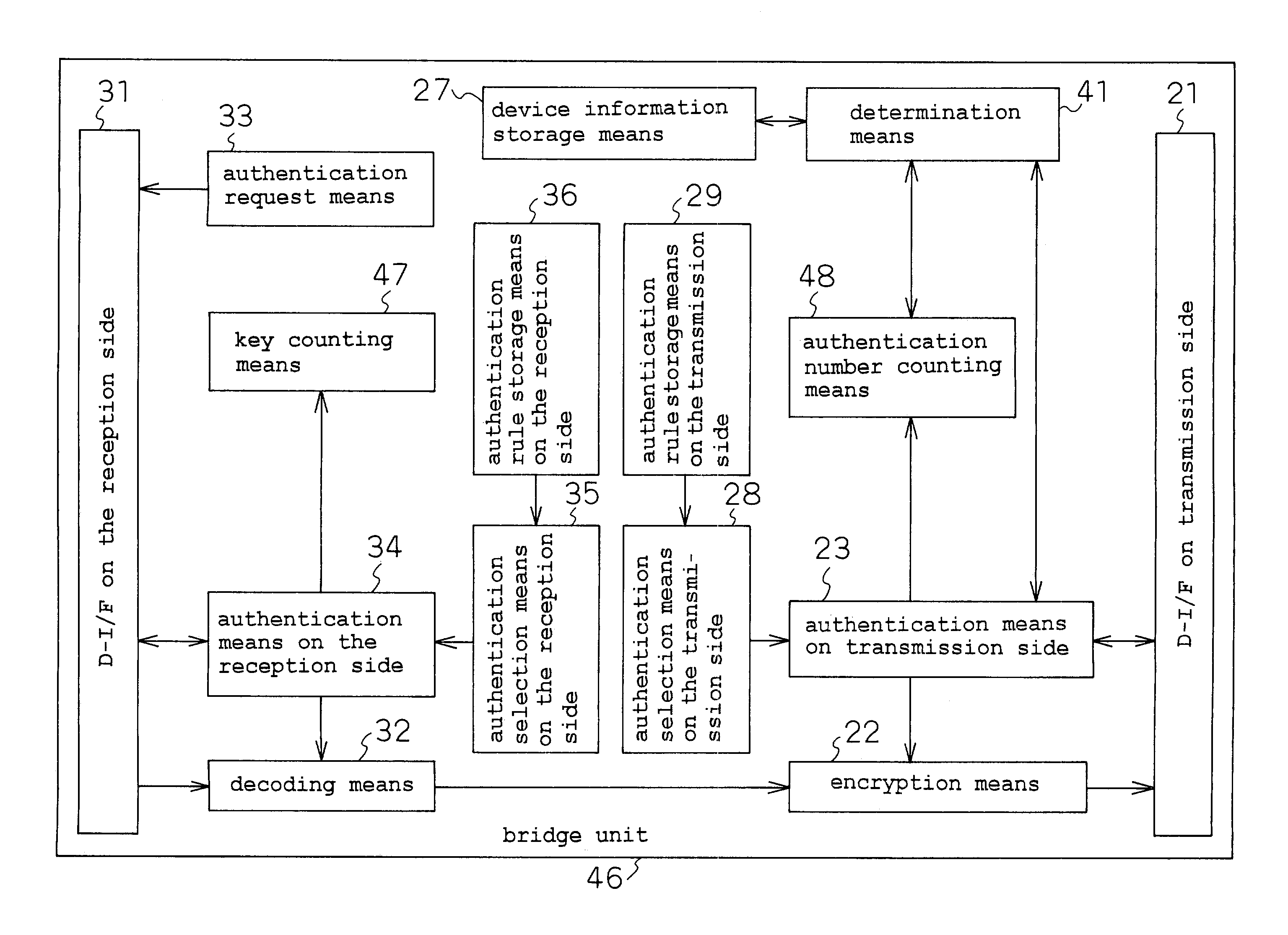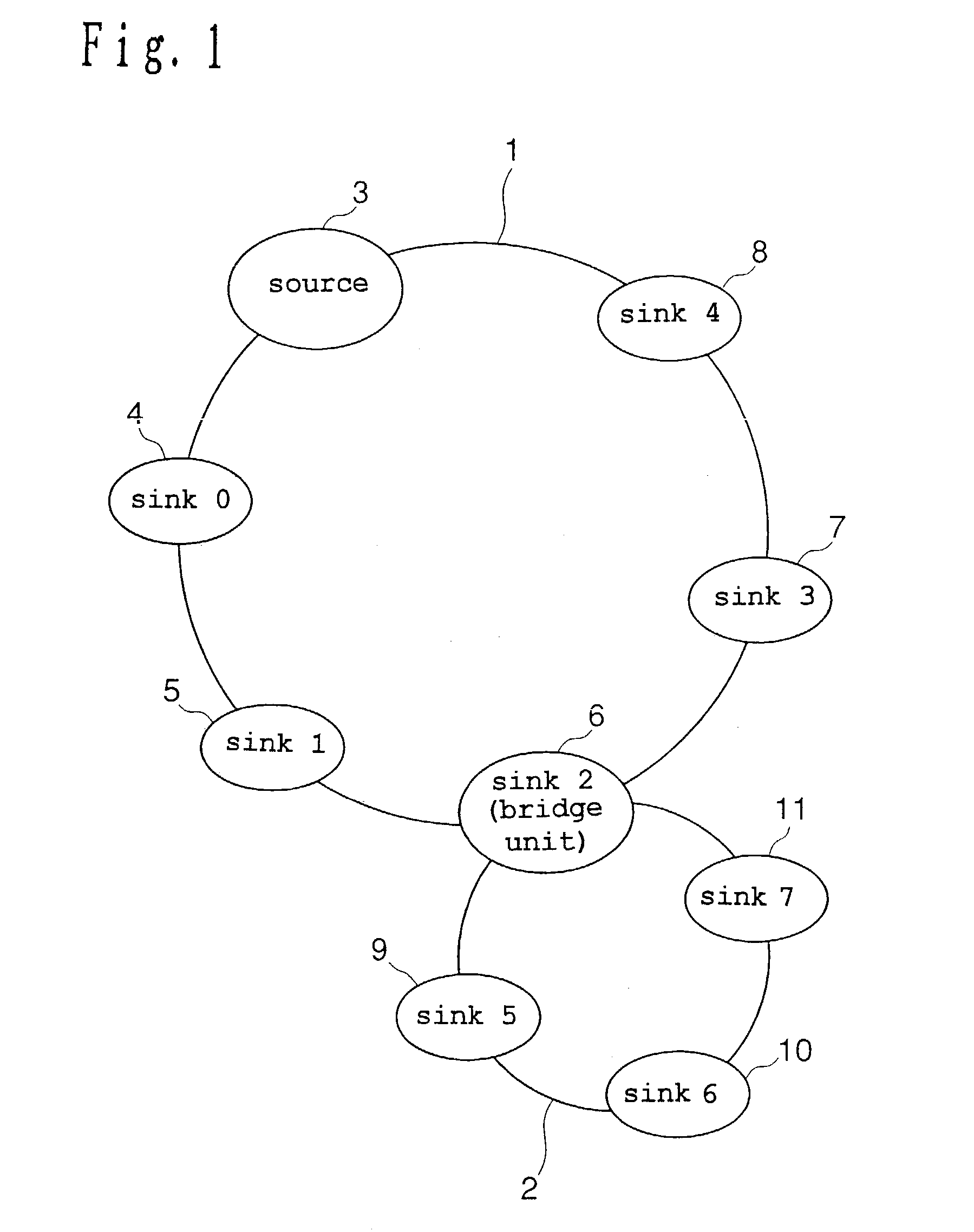Copyright protection system, transmitter, receiver, bridge device, copyright protective method, medium, and program
a copyright protection and transmission device technology, applied in the field of copyright protection systems, can solve the problems of limited number of reception apparatuses that can receive signals from the apparatus that becomes a signal source, and the desire of copyright holders to limit the number of reception apparatuses, so as to achieve a maximum of sixty-three apparatuses
- Summary
- Abstract
- Description
- Claims
- Application Information
AI Technical Summary
Benefits of technology
Problems solved by technology
Method used
Image
Examples
first embodiment
[0299]First, the first embodiment is herein described.
[0300]FIG. 1 shows a copyright protection system according to the present embodiment.
[0301]In the copyright protection system according to the present embodiment, IEEE 1394 bus #1 (1) and IEEE 1394 bus #2 (2) are connected to each other by means of a sink 2 (bridge unit) (6) while source 3, sink 0 (4), and the like, are connected to IEEE 1394 bus #1 (1). In addition, sink 5 (9), sink 6 (10), and the like, are connected to IEEE 1394 bus #2 (2).
[0302]IEEE 1394 bus #1 (1) and IEEE 1394 bus #2 (2) are, respectively, different IEEE 1394 buses.
[0303]The source 3 is an apparatus for transmitting AV data requiring copyright protection to IEEE 1394 bus #1 (1) and is, for example, an STB (set top box).
[0304]The sink 0 (4), the sink 1 (5), the sink 3 (7) and the sink 4 (8) are connected to IEEE 1394 bus #1 (1) and are apparatuses receiving and utilizing AV data requiring copyright protection transmitted from the source 3 and are, for exampl...
second embodiment
[0403]Next, the second embodiment is described.
[0404]A copyright protection system of the present embodiment is shown in FIG. 1 in the same manner as of the first embodiment.
[0405]FIG. 5 shows a source 3 of the present embodiment as an STB 40. The difference from the STB 20 of the first embodiment is the point that the STB 40 is provided with a determination means 41 instead of the count adjustment and determination means 26.
[0406]The determination means 41 differs from the count adjustment and determination means 26 described in the first embodiment and does not carry out a determination of whether or not an authentication request is a repeated authentication.
[0407]In addition, a sink 0 (4), a sink 1 (5), and the like, do not arbitrarily carry out an authentication request again, unlike in the first embodiment. That is to say, the apparatuses, such as the sink 0 (4) and the sink 1 (5), connected to IEEE 1394 bus #1 (1) do not carry out a repeated authentication request until the so...
third embodiment
[0430]Next, the third embodiment is described.
[0431]A copyright protection system of the present embodiment is shown in FIG. 1 in the same manner as in the first embodiment.
[0432]FIG. 7 shows a source 3 of the present embodiment as an STB 42. The STB 42 of the present embodiment does not, unlike the STB 20 of the first embodiment, carry out decrement authentication but, instead, the STB 42 periodically examines whether or not the sink 1 (5), or the like, has stopped decoding AV data or displaying the AV data on a monitor. That is to say, the STB 42 of the present embodiment is provided with an examination means 43 and a correspondence table storage means 50 unlike the STB 20 of the first embodiment and, in addition, is not provided with an authentication rule storage means 29 nor an authentication selection means 28 on the transmission side.
[0433]The examination means 43 is a means of periodically examining whether or not the sink 1 (5), or the like, has stopped decoding AV data or ...
PUM
 Login to View More
Login to View More Abstract
Description
Claims
Application Information
 Login to View More
Login to View More - R&D
- Intellectual Property
- Life Sciences
- Materials
- Tech Scout
- Unparalleled Data Quality
- Higher Quality Content
- 60% Fewer Hallucinations
Browse by: Latest US Patents, China's latest patents, Technical Efficacy Thesaurus, Application Domain, Technology Topic, Popular Technical Reports.
© 2025 PatSnap. All rights reserved.Legal|Privacy policy|Modern Slavery Act Transparency Statement|Sitemap|About US| Contact US: help@patsnap.com



